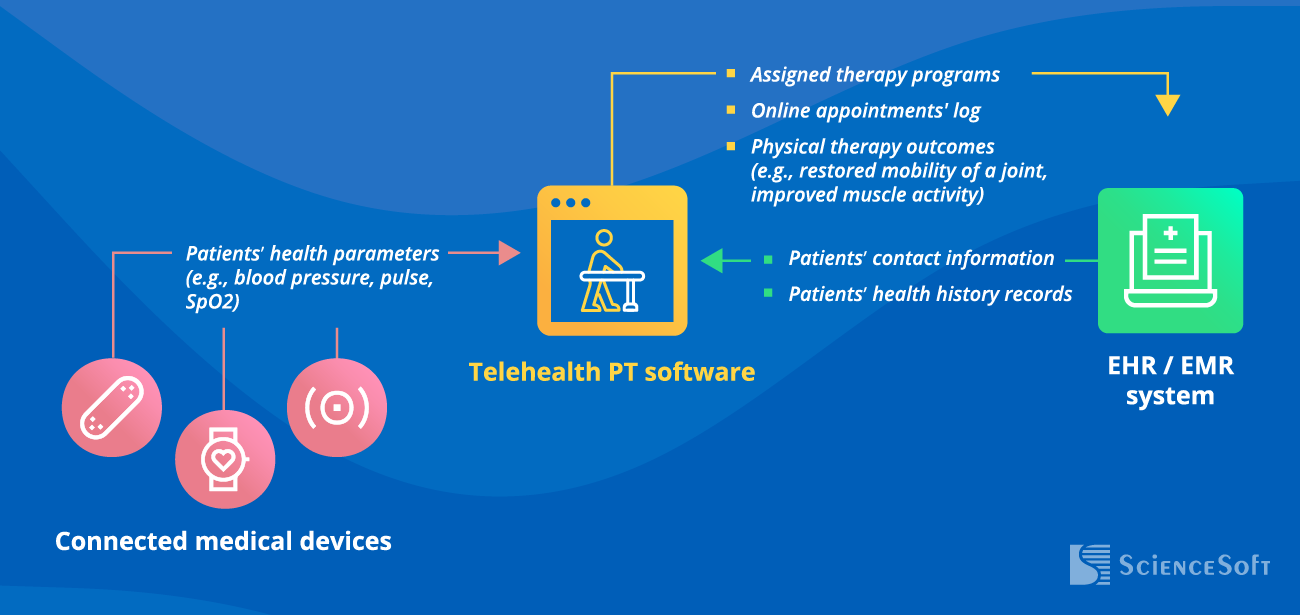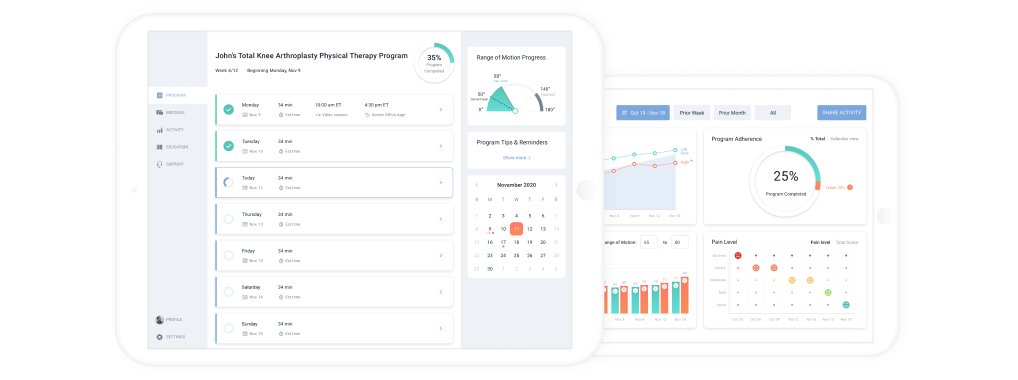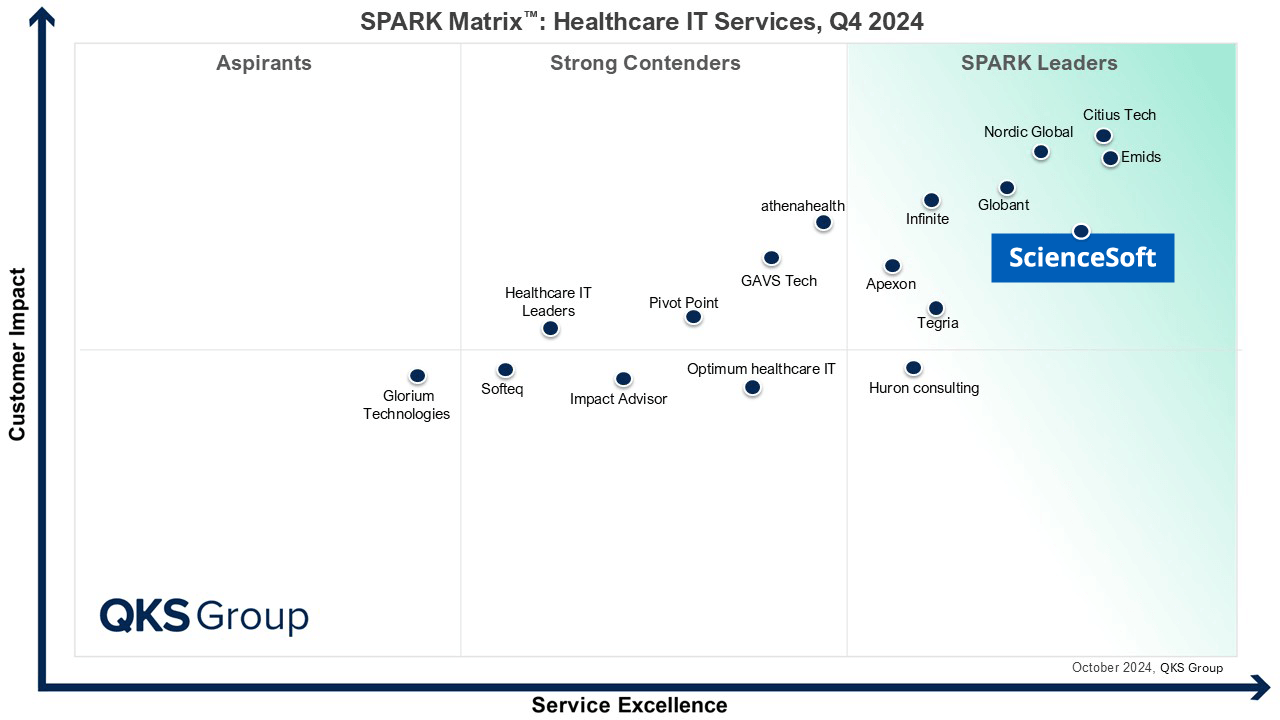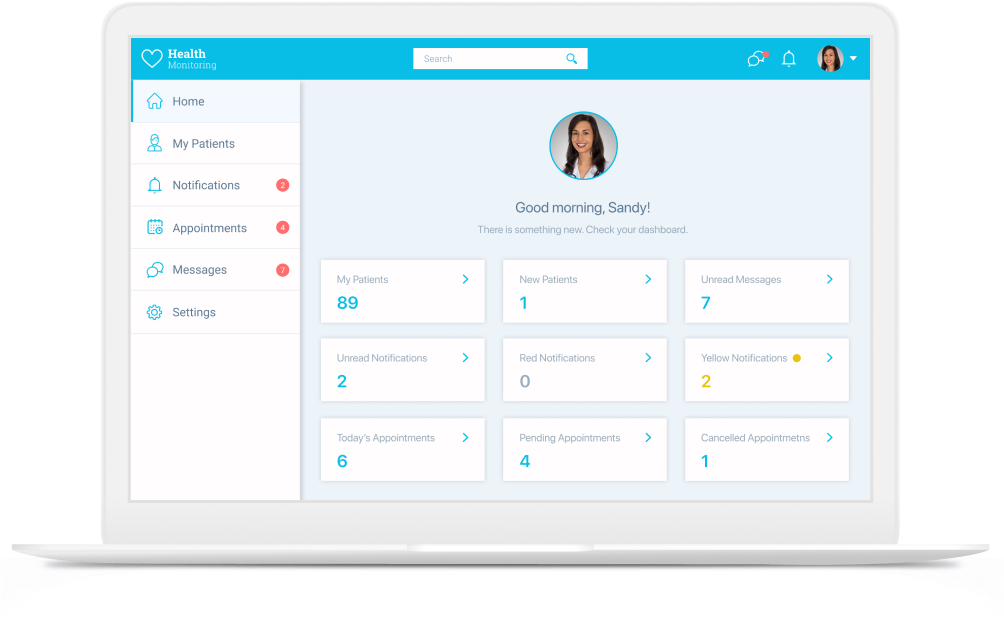Custom Telehealth Software in Physical Therapy
Complete Overview
ScienceSoft employs its 20 years of experience in healthcare IT to design and develop robust physical therapy telemedicine software for healthcare organizations and software product companies.
The Essence of Telehealth for Physical Therapy
Telehealth technology helps physical therapists foster patients’ rehabilitation after injuries and surgeries, manage chronic conditions (e.g., arthritis), and provide care for professional athletes remotely. Telemedicine software enables remote delivery of physical therapy, improves care continuity, and promotes better treatment adherence. Custom telehealth software for physical therapy is especially useful as it allows healthcare providers to deliver tailored treatment and rehabilitation plans, which contributes to personalized and targeted care, satisfied individual needs of patients, and maximized therapy outcomes.
The cost of developing a telehealth app for physical therapy ranges from $150,000 to $400,000. Use our free cost calculator to learn the software development budget for your case.
Architecture of a Telemedicine Solution for Physical Therapy
The main elements of the telemedicine platform for PT are a cloud server with a data storage and processing module and a video streaming server, an app for patients, an app for physical therapists, and an admin web panel.
The solution can be integrated with EHR/EMR software using standards-based APIs (e.g., FHIR/HL7) and mapped to USCDI data classes and clinical terminologies (e.g., ICD-10, SNOMED CT, LOINC, RxNorm) to keep the data cohesive across systems. Additionally, a telehealth application can be integrated with smart medical devices (e.g., heart monitors, wearable smart watches) or sensors (e.g., computer vision for motion tracking) to monitor the physical therapy progress and treatment adherence.

The main elements of the solution include:
App for patients
to view and follow physical therapy programs, record therapy sessions, contact a therapist for help and guidance, etc.
Admin web panel
to allow hospital administrators, supervisors, or private practice therapists (when SaaS model is used) to view a list of physical therapists and patients, grant the app access to patients and physiotherapists, add new physical therapy programs, etc.
App for physical therapists
to assign physical therapy programs, manage treatment, monitor therapy progress, patients’ health parameters, etc
Key Features of a Telehealth Application for Physical Therapy
At ScienceSoft, we create a unique set of physiotherapy telehealth app features for each client to cater to their specific business needs. Here is the list of core features we implement that encompasses most of physical therapy software use cases.
Important Integrations for Telehealth PT Software
 To enable automation of patient data entry and get an overall picture of patient health while planning and conducting remote physical therapy sessions, ScienceSoft suggests integrating the telehealth PT application with:
To enable automation of patient data entry and get an overall picture of patient health while planning and conducting remote physical therapy sessions, ScienceSoft suggests integrating the telehealth PT application with:
to ease access to the patient health information (e.g., diagnoses, chronic conditions) for physical therapists and log e-visits in EHR for the streamlined gathering of billing information.
to collect and analyze patients’ health parameters (e.g., blood pressure, pulse, SpO2) in real time, adjust the physiotherapy, track treatment results and effectiveness.
How to choose technology for medical device integration with a telehealth app for PT?
We recommend choosing connectivity technology (e.g., Wi-Fi, NFC, Bluetooth) for smart medical device integration based on the device properties, manufacturers, security concerns, and requirements of your healthcare organization. For example, Bluetooth is often used to securely connect smartwatches or sensors.
How to Create Telehealth Software for Physical Therapy
When building a custom telehealth solution for physical therapy, having a well-structured plan is vital to ensure a successful project outcome. Below, ScienceSoft outlines the key steps involved in the development process:
1
Analyzing and documenting the specific requirements of your physical therapy practice, including the desired functionalities, patient engagement features, and integrations.
2
Introducing a tailored feature set, defining the architecture design, and selecting the tech stack.
3
Creating a project plan, outlining the deliverables, KPIs, project milestones, development budget and schedule for transparent project management and resource allocation.
4
Building the telehealth software for physical therapy according to the project requirements and design specifications.
5
Conducting testing and QA to ensure the solution’s functionality, stability, security, and regulatory compliance (e.g., with ADA, HIPAA, HITECH, GDPR, PCI DSS).
6
Migrating patient records and therapy data from the existing systems to the new software for guaranteed care continuity.
7
Integrating the telehealth software with the necessary external and internal systems (e.g., EHR/EMR, billing systems) and smart medical devices (e.g., motion sensors, pain relief machines).
Should You Opt for a Custom Telehealth App for PT?
ScienceSoft has prepared a few simple questions that will help you determine whether you need a custom-made telemedicine solution for virtual physical therapy.
Do you want your telehealth app to be integrated with medical devices or sensors? For example, to track patient activity and range of movement, help monitor complications, etc.
Do you plan on designing unique physical therapy programs (e.g., pre-recorded and animated videos or VR-based physiotherapy)?
Do you have a complex IT environment and/or legacy software (EHR, RCM, practice management, etc.) and need to seamlessly integrate the telehealth app into it?
Do you want to automate physiotherapy patients’ progress assessment with AI-driven analytics?
Tell us more about your needs
Please answer at least one question to help us better understand your business objectives.
A ready-made app may cover your needs
It looks like an out-of-the-box solution is just right for your organization. If you need to choose and implement the best-fitting telenursing app, ScienceSoft’s experts are ready to help you.
A custom telehealth app for PT is the way to go
Based on your answers, it seems you should opt for a custom telehealth app for PT. ScienceSoft’s healthcare IT experts with 5-20 years of experience will be glad to help you define the necessary features, design a robust architecture, and develop your telemedicine solution.
What Determines the Success of a Telehealth App for Physical Therapy
Between January and October 2024, Medicare processed 2.3 million telehealth physical therapy claims. This volume is 340% higher than pre-pandemic levels, which shows how sharply physical therapists expanded virtual care. To ensure telehealth appointments bring benefits to the patients, ScienceSoft's experts recommend to consider the following factors:
Easy in-app therapy programs search, editing, and adding
to allow physical therapists to set up an effective patient therapy program fast.
Gamification of physical therapy
to motivate patients (e.g., points for completing a therapy session or reaching predefined therapy milestones, in-app badges for progress).
Clear UI and intuitive UX
to help patients navigate through remote physiotherapy sessions and the telehealth application’s features, e.g., with pop-up text or voiced recommendations (especially relevant for geriatric care).
Examples of Telemedicine for Physical Therapy
- Essen Health Care, an NYC-based medical group, implemented a telehealth-based virtual physical therapy, rehabilitation, and RPM program. The organization witnessed a 20% reduction in the rehabilitation period, and patient adherence increased by 65% compared to in-facility adherence.
- Exchange Physical Therapy Group, a practice with three clinic locations in New Jersey, implemented telehealth for physical therapy in response to the COVID-19 pandemic. Around 10% of their patients used telehealth to stay active and continue rehabilitation.
Telehealth App for Physical Therapy: a Success Story by ScienceSoft

Client: Aklos Health, a US-based software product company.
Solution: A wearable-based physiotherapy platform, including a mobile and a web app.
Key features:
- An in-app personalized therapy plan with detailed exercise video instructions.
- Patient progress reports based on the range of joint motion data from the wearable sensors.
- Instant text messaging between patients and therapists.
- Access to educational content.
Project highlights: ScienceSoft developed proprietary algorithms for Xsens DOT wearable sensors to accurately assess the knee joints and low back mobility.
Benefits of Telehealth PT
Increased adherence
to physical therapy treatment due to convenient therapy delivery at patients’ homes (Healthcare IT News).
Better patient outcomes
due to easy control of treatment efficiency and PT plan personalization (Physical Therapy Journal).
Costs of Physical Therapy Telehealth Software

The cost of a telehealth solution for physical therapy with core features like video, chat, and file exchange usually ranges from $150,000 to $200,000. The investments may increase to $300,000 or $400,000 for an advanced solution with integrated medical devices, AI functionality, etc.
Need a tailored cost calculation for your app?
Learn more about telemedicine software development cost factors and ROI.
Telehealth Software for Physical Therapy by ScienceSoft
Holding ISO 13485 certification, ScienceSoft creates efficient telemedicine apps for PT according to the requirements of the FDA and the Council of the European Union.
Our awards, recognitions, and certifications

Featured among Healthcare IT Services Leaders in the 2022 and 2024 SPARK Matrix
Recognized for Healthcare Technology Leadership by Frost & Sullivan in 2023 and 2025
Named among America’s Fastest-Growing Companies by Financial Times, 4 years in a row

Top Healthcare IT Developer and Advisor by Black Book™ survey 2023
Recognized by Health Tech Newspaper awards for the third time (2022, 2023, 2025)

Named to The Healthcare Technology Report’s Top 25 Healthcare Software Companies of 2025
ISO 13485-certified quality management system
ISO 27001-certified security management system
About ScienceSoft
ScienceSoft is an international IT consulting and software development company headquartered in McKinney, Texas, US. Since 2005, ScienceSoft has been rendering expert consulting and development services for telemedicine applications and helped healthcare organizations provide quality remote physical therapy to improve patient care and quicken rehabilitation. Our top priority is driving project success no matter what while keeping to the agreed time and budget and responding to uncertainties agilely.






